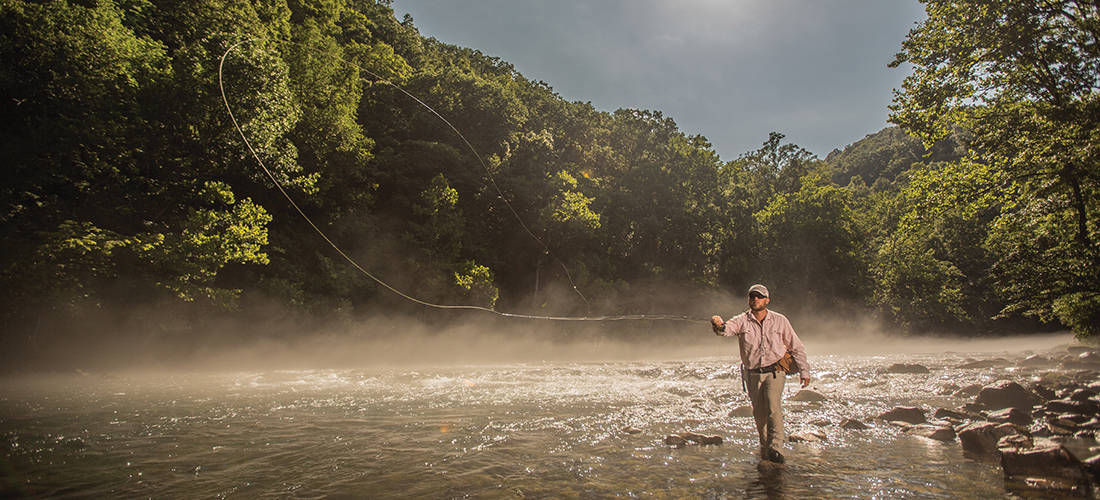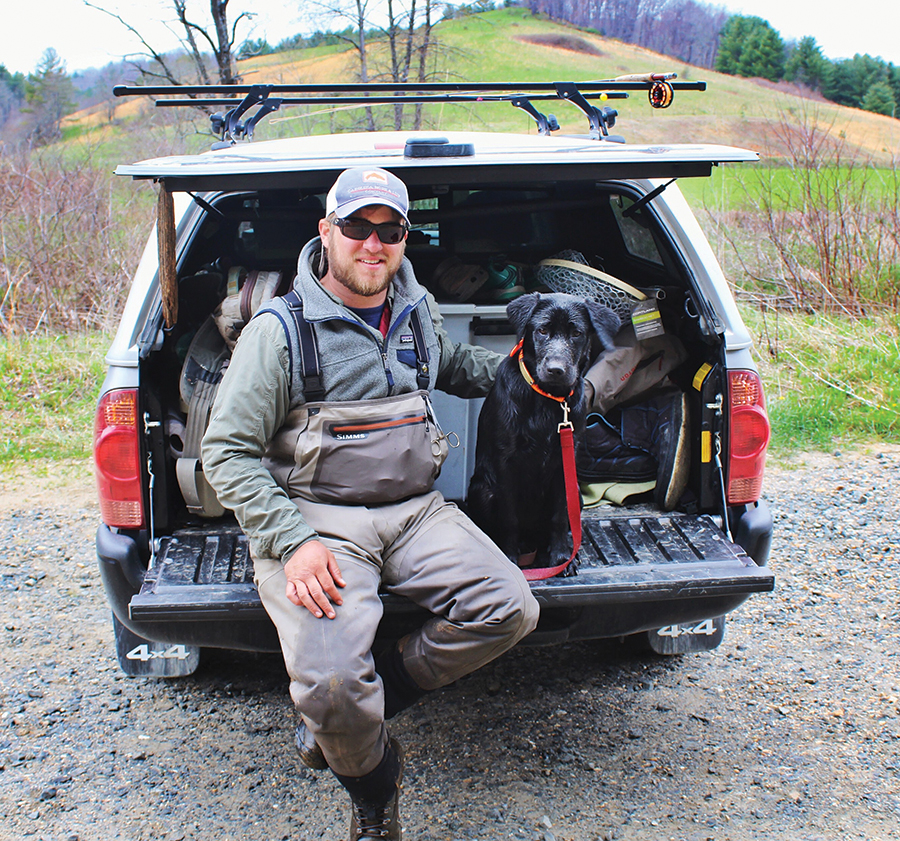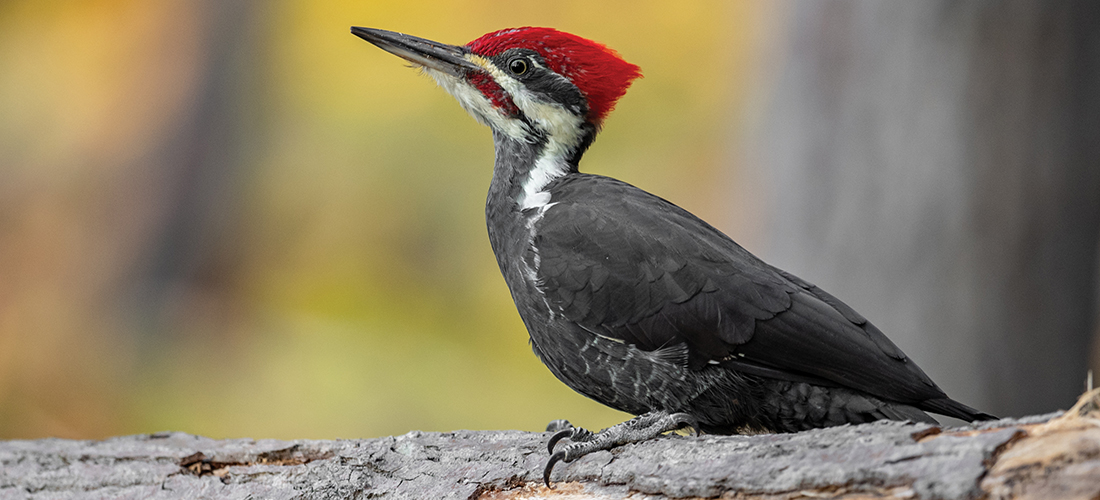
A fly-fishing son of Pinehurst reels in mountain adventures
By Ron Rhody
Cape Lookout, that southern tip of North Carolina’s barrier islands, reachable only by boat — remote, rugged, and most appealing of all, unspoiled.
A couple of hours past midnight.
The beach deserted.
The only sounds that of surf breaking on sand. The only light the faint glow the stars provide.
Kneeling in the surf, a man and a boy, father and son.
The boy, beaming, unhooking a 46-inch red fish, spreading his arms, lifting it triumphantly.
The man beaming just as broadly. A trophy catch taken on rod and reel in the surf of the Outer Banks early on a morning when less determined men are home in bed.
The man laughs, shakes his head appreciatively. “You’re good at this. If all else fails, you’ve got this to fall back on.”
Patrick Sessoms laughs, too. Though he loves it, has loved it since he first threaded bait on a hook as a grade-schooler and went trying for panfish in the little ponds around Pinehurst, fishing isn’t what he has in mind for a career.
He’s 17, just finishing his senior year at Pinecrest High School. There is a universe of dreams to pick from.
That boy who had a talent to fall back on if all else failed hasn’t fallen back on it. He’s grabbed it. And is in the process of creating one of the most successful fly-fishing guide services in the southern Appalachians.
Fly-fishing? The mountains of the southern Appalachians?
A guide service — one of the most professionally challenging, physically demanding, hands-down competitive enterprises on the list of ways a man might make a living?
Alone? Inexperienced?
That’s what a bright, well-educated, ambitious young man at the start of a career that could take him anywhere might choose to do? Go fishing?
Aw, come on.
It’s about an hour before daylight.
Patrick’s driving. We’re on a twisting two-lane road winding through the northern edge of the Blue Ridge Mountains on our way from Boone, where Patrick lives now, to the South Holston. I’ve been told the South Holston is one of the finest tailwater trout fisheries east of the Mississippi. Big browns, enormous browns, lots of rainbow. I’m a recent transplant from California. I’m familiar with tailwaters. The world’s best are in the West.
There is a special quality to the dark of a mountain road in the hours before daylight — the blackest of black because all light of any kind has bled away, and all the warmth, and all that’s left is the cold.
We’ve seen no lights at all since clearing Boone, but we’re snug inside Patrick’s truck, and the drift boat trailing behind is riding smoothly, and the coffee in my Yeti mug is hot, and we’re getting acquainted, finding out about each other.
That’s one of the most important elements of this form of fishing, the connect.
We met only a short time ago in the parking lot at Patrick’s fly shop in Boone, where I piled out of my car in the morning dark and into his truck for the run to the river. A hello, a handshake, a let’s go. He has the build of a linebacker and a reassuring smile. We have over an hour’s drive to the South Holston and want to be on the water by first light. We’ll be spending the rest of the day in a drift boat. Two strangers. If the connect is good the day will be a fine one, regardless of how good the fishing is. If it isn’t, well . . . but this is going to be fine. He’s one of that rare breed of instantly likeable people — warm and amiable.
Patrick Sessoms is from Pinehurst.

The village sits on the bed of one of the ancient lakes formed thousands of years ago from Ice Age glacier melt. With a population of a little over 16,000, it is the largest in Moore County, and Moore County is the most affluent in the area, which is called, thanks to the glaciers’ leavings, the Sandhills. America’s premiere golf resort, the Pinehurst Resort and Country Club, home of the world-famous Pinehurst No. 2, is there. It’s rural, pastoral, uncrowded — a comfortably peaceful landscape of rolling meadows, stands of longleaf pines and sawgrass, the sort of place where the enchantments of the natural world can get in your blood.
The Sessoms have been in Moore County since the 1800s, carpenters and builders mostly. There are Sessoms homes and structures all over the county. Patrick’s father, Clay, built my home in Pinehurst. Patrick is fourth generation.
As a boy he roamed the woods, fished the little ponds and streams, learned the bird calls and when the redbuds would bloom. Became addicted to the outdoors. Don’t misapply the word. There are good addictions.
Episcopal Day School, Pinecrest High, National Honor Society, student government, cross-county runner, a winning member of the Sandhills Cycling Club regional competitive team, Eagle Scout.
Underscore Eagle Scout.
Cue serendipity.
The Eagle Scout rank is the highest achievement in the 2.4-million member Boy Scouts of America program. Candidates have to progress through five stages of development and earn 21 merit badges (proof of knowledge and competence in a wide range of life skills) to win it. Less than 4 percent do.
Patrick needed only one more. And chose the one just recently added to the program.
Fly-fishing.
This was an entirely new experience for a flat-country boy. Though he had been fishing since grade school, the implement was either a long cane pole sporting a length of monofilament and a bobber and barbed hook with live bait attached, or a spinning rod that could present either live bait or an artificial lure. Both worked in their place and for their targets. But, as Patrick was to learn, neither had the elegance, or demanded the skills, or generated the adrenalin rush that fly-fishing does.
He was, forgive the pun, hooked.
Not firmly at first. He was only 13 and in the Sandhills, and his options were limited to bass in Lake Pinehurst or panfish in the area’s farm ponds and streams.
The hook doesn’t really get set until he finds himself in Boone . . . his second try at college.
He had thought he would follow the familiar family path into building and construction and had enrolled as a construction engineering student at North Carolina State University in Raleigh.
It didn’t take.
He didn’t like living in the city. He missed the outdoors. He found he was more interested in environmental matters than in building things, transferred to Appalachian State University in Boone, enrolled in its sustainable development program, the oldest program of its type in the country. It is focused on ensuring that the planet’s ability to provide the natural resources our societies need to survive and prosper are sustained.
That took. As did Boone.
A vibrant community with the main campus of Appalachian State at its center, Boone was small enough to be livable, had enough action to be cool without being annoying, and was smack in the heart of a Mecca for outdoors recreation — North Carolina’s high country, a seven county stretch of mountains and streams along the border with Tennessee.
There was a year-round smorgasbord of delights on offer there: hunting, skiing, hiking, mountain-biking, camping, kayaking, bird-watching, zip-lining, or just the simple pleasure of sitting and admiring sunsets soothed by bird song and the whisper of water in mountain streams . . . and some of the best trout fishing in the Southeast.
The only thing that did take at N.C. State was Meredith . . . Meredith Duyck, of Asheville.
By the time he made it to Boone, Patrick had mastered the fly rod. He could make the graceful cast, drop the fly gently on the spot of water he’d chosen so as not to startle his quarry, manage a drag-free draft to ensure his lure was moving at the same rate of speed as the current so that it would be seen as something natural, not suspect. Watch for the strike. Set the hook. Savor the fight.
Patrick began guiding while still a student at Appalachian State. He worked on weekends and off-hours from school for one of the local guide services. Found he was good at it. Found he had the personality and patience and the mastery of the skill. He had learned the waters and knew the holds where fish could be found. He could put his clients on fish and bring them home happy — even if they didn’t land anything, though that seldom happened.
He enjoyed it. They enjoyed it.
He began to wonder.
For some, fly-fishing is the apex of the sport-fishing skill. Its canon stretches back to 16th century England, where the art got its start among the English upper class. For years it was a relatively exclusive niche sport. There were ardent participants, but not too many, until Robert Redford put a fly rod in the hand of the young Brad Pitt on one of the most beautiful streams in the country and turned Norman McLean’s classic semi-autobiographical novel into the 1992 Academy Award movie A River Runs Through It.
Remarkably, the film struck a chord in the psyche of large swatches of the American population. It seemed to awaken a latent longing for the peace and beauty of the out-of-doors. All at once, fly-fishing was popular, or at the very least, fashionable. What better way to experience the great outdoors than with the graceful motion of a fly line uncurling over running water in the solitude of a mountain stream, and images of yourself, Brad Pitt-like, thigh-deep in a swift current with a big rainbow on the line?
Field & Stream magazine estimates there are roughly 10 million flyrodders in this country now, and their number is growing. According to the Outdoor Foundation’s latest report, the growth rate in 2017 was 17 percent. At least 5 million are rated as avid enthusiasts. Committed golfers will recognize the type. They fish as often as they can. Mastering the perfect cast is as technical and demanding as mastering the perfect golf swing. No one does either, but the desire is constant.
The competition for their business is intense. There are eight guide services in the Boone area alone.
So he’s finishing up at Appalachian State on the backside of the punishing recession of ’08-‘09. The economy is still staggering. Jobs are scarce. His graduating buddies are scrambling in a job market with few opportunities and little demand for their degrees. What few jobs are being found aren’t using their skills or paying decent wages. He finds that he’s making more money than many of them.
Guiding. Doing what he likes to do. Doing what he’s good at.
So, with graduation day in sight, in the teeth of that blooming gale, he decides to play the hand he’s holding. He launches Due South Outfitters. In Boone.
By himself.
He’s 21.
He has no experience as a businessman.
A full-fledged guide service is a business. It needs funding, equipment, operating capital. Patrick has little more than a drift boat, a truck, a fly rod and some flies. It needs bookkeeping and marketing. What does he know about that? Where does he find the time? If he’s not on the water, he’s not making money.
As word of mouth spreads among his regulars that he’s gone pro, his trip log starts to grow. His universe of clients expands. And keeps expanding. Satisfied clients are the best advertising.
In that first year after graduation he logs over 300 days on the water, scouting and guiding. He lives in his room, works out of his truck, pumps all he earns back into the business. Frugality becomes a mantra, sleep an ambition.
Fourteen-hour days are normal — eight hours on the water, three hours of preparation on either side getting there and getting back, setting the boat up and cleaning it up after, re-rigging rods and refreshing flies.
Not only are the hours long, the work is hard . . . physically hard. His loaded drift boat weighs 1,500 pounds. The anglers sit at the bow and stern and the guide in the middle with the oars. Not all that much effort is required to keep the boat moving in sync with the current, but when running rapids, or if there is a snag to be loosened, or a hold to be rowed back to against the current for another try at the rainbow that should have taken the fly but didn’t, the strength and skill required are considerable. Try that all day.

Soon, the demand is larger than one man can handle, and he begins to recruit. But he has a different paradigm in mind than the conventional guide service. He wants young men like himself — bright, upbeat, likeable — who he can teach and train in the manners and techniques he thinks makes the consummate guide and who share his commitment to, and respect for, the natural environment . . . a team of enthusiastic young pros who can meet the expectations of accomplished anglers on a quest for trophy fish, or give first-timers a day they’ll remember and want more of.
There are 14 of them now.
They are handpicked and personally trained by Patrick. All are accomplished fly-fishermen. They have the personality and the dependability that are the hallmark of top-flight guides and may be the best-educated team in the country. All are students or recent graduates of Appalachian State. They range in age from 17 to 26. Most are business majors or outdoor recreation majors. A few are in the construction management stream. There is one MBA.
The team specializes in float trips on the South Holston and the Watauga. These are side-by-side tailwaters that are productive year-round and boast fish counts of 4,000 to 6,000 per mile of stream. Only a mountain ridgeline separates the two.
In the spring and early fall, wade trips on the high country’s backwoods streams for native Appalachian brook trout and small-mouth bass become popular.
Whether drift boat or wading, Patrick and his team are enthusiastic teachers. They have first-timers laying casts that take fish after an hour or so of instruction at the start of a trip. Youngsters as young as 8 are increasingly showing up with a dad or an uncle on family outings. Women, too. The simple elegance of the cast and the tranquility of the settings seem to appeal to them.
The client base is broad and growing, ranging over most of the Southeast and edging northward. Much of this is due to the attraction of the high country as a tourist destination, but the adroit use of social media to raise awareness of Due South’s presence and services plays a major role.
Regular Facebook postings highlight catches and report on trips and results. YouTube videos offer advice on techniques and equipment. The website (duesouthoutfitters.com) has up-to- date information on stream conditions and information on how to book trips. There is even a podcast. These are millennials. They understand how to use the tool.
Patrick is expanding into retail now, adding a fly shop to the guide service. The shop is one of the best-stocked in the high country, certainly the best-stocked in Boone. Top-of-the-line stuff in hand to be inspected, tried out, decided on — not just pictures in a catalog. Rods, reels, waders, flies — the universe of gear and gadgets fly-fishermen need, want, or just can’t resist. A businessman’s instincts?
Even so, Patrick is still on the water himself regularly, guiding six to seven days a week, making sure he knows how the waters are fishing and where the action is. But this businessman thing, he’s taking to it.
Oh, about Meredith, Meredith Duyck, of Asheville.
She and Patrick met that freshman year at N.C. State. When he left for Boone, she stayed in Raleigh to finish the degree in business management and marketing she was working on. But the attraction didn’t fade. It was a long-distance romance. He took her fishing. She was smitten. He proposed on the Watauga on a favorite stretch just below the dam. They have a daughter now, Ruth, not quite 2, and Meredith, young mother and homemaker, is fly shop manager and Due South’s principal logistician. She is an ardent conservationist, past president of the local Trout Unlimited chapter, a mentor to women flyrodders, and shapes casts as graceful as the leader of the team.
Due South Outfitters is eight years old now.
Patrick is 29.
The business is thriving — put on hold during the recent COVID-19 lockdown, but back in action. The rivers are running strong and fresh, fish are feeding and growing, and the solace of a day in the arms of nature on a mountain stream has never been more healing.
Fly-fishing?
The mountains of the southern Appalachians?
A guide service?
Damn right! PS
Ron Rhody came to Pinehurst after a career as a journalist and corporate public relations executive. He’s writing novels now. His latest is due out in the early spring of 2021.





